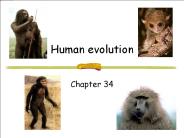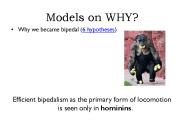Hominins PowerPoint PPT Presentations
All Time
Recommended
Backpedaling in human evolution Adaptive values of bipedalism in reverse J.K. McKee, A. Kolatorowicz, L. Reitsema, A. Ruth, S. Schlecht, O. Ulvi, T. Weston
| PowerPoint PPT presentation | free to download
4-3 mya bipedal although these animals probably also were comfortable in the trees ... Stone tools and hunks of rock. Provenience ...
| PowerPoint PPT presentation | free to view
H habilis as early as 2.3 mya to about 1.5 mya. Lived at same time as A boisei and possibly at same ... Oldowan basalt choppers and chert flakes. Homo habilis: ...
| PowerPoint PPT presentation | free to view
size between gibbon and chimpanzee. principally arboreal, not exclusively. preference for upright posture. some bipedalism, in trees & ground ...
| PowerPoint PPT presentation | free to view
Possibilities Raised by the Dmansi Discoveries First hominins to leave Africa were small-bodied early form of H. erectus, with smaller brains than later forms and ...
| PowerPoint PPT presentation | free to download
Primate Evolution Chapter 16 16.2 Hominoids to Hominins Hominins The lineage that most likely led to humans split off from the other African apes sometime between 8 ...
| PowerPoint PPT presentation | free to view
Anthropometry Measurement of human body Identifying human variation due to ... Slide 6 Physical Anthropology Challenges Evolution Species Hominins A ...
| PowerPoint PPT presentation | free to download
Introduction to African Prehistory James Denbow Course pdf files Week 1: Introduction to Continent Week 2: Climate, language & culture Weeks 3 & 4: Early Hominins
| PowerPoint PPT presentation | free to download
Models on WHY? Why we became bipedal (6 hypotheses) Efficient bipedalism as the primary form of locomotion is seen only in hominins. Origins of all these bipedalism ...
| PowerPoint PPT presentation | free to download
Hominin Evolution * * * Pre-dating Australopithecus Hominins discovered in north-central and eastern Africa Bipedal debatable in some species We will focus on the ...
| PowerPoint PPT presentation | free to download
... the first bipedal hominins would have been good climbers (as are chimpanzees) ... woodland habitats where it would have been impossible to see predators ...
| PowerPoint PPT presentation | free to view
Lesson Overview 26.3 Primate Evolution The Oldest Hominine? Sahelanthropus had a brain about the size of a modern chimp, but its short, broad face was more like that ...
| PowerPoint PPT presentation | free to download
16 minutes ago - COPY LINK TO DOWNLOAD = flip.ebookmarket.pro/psjul24/B0BR6431J5 | [PDF READ ONLINE] Homo Sapiens Rediscovered: The Scientific Revolution Rewriting Our Origins | Who are we? How do scientists define Homo sapiens, and how does our species differ from the extinct hominins that came before us? In this accessible account palaeoarchaeologist Paul Pettitt shows how the latest scientific advances, especially in genetics, are revolutionizing our understanding of human evolution. Pettitt reveals the extraordinary story of how our ancestors adapted to unforgiving and relentlessly changing climates, leading to remarkable innovations in art, technology, and society that we are only now beginning to comprehend.Drawing on twenty-five years of experience in the field, Pettitt takes listeners from the caves and rock-shelters that provide
| PowerPoint PPT presentation | free to download
Arid plains environment of eastern Africa. Ardipithecus ramidus. One of the earliest hominins that lived in eastern Africa about 5.8 to 4.4 million years ago. diastema ...
| PowerPoint PPT presentation | free to view
Human evolution Chapter 34 ...
| PowerPoint PPT presentation | free to download
The Five Kingdoms What characteristics are shared by all living things? Eukaryotes Prokaryotes Three Domains An alternative classification system ANIMALS What are ...
| PowerPoint PPT presentation | free to download
Lesson Overview 26.3 Primate Evolution
| PowerPoint PPT presentation | free to download
... g. orangutans), lesser apes (e.g. gibbons) and other primates (e.g. monkeys, baboons) ... Gibbon. Orangutan. Hominin Evolution ...
| PowerPoint PPT presentation | free to view
Title Are Humans Special? Our Place in a Scientific Map of Reality Author: Christian Last modified by: dgc Created Date: 4/4/2003 9:41:56 PM
| PowerPoint PPT presentation | free to download
Australopithecus aethiopicus. Temporal fossa. Sagittal crest. Zygomatic arch. boisei. robustus ... afarensis. boisei. africanus. robustus. Homo habilis ...
| PowerPoint PPT presentation | free to view
Computer modelling is more abstract and mathematical. Benefits to ... SIMILE. Visual modelling software. Earth, environmental ... Simile can link up to ...
| PowerPoint PPT presentation | free to view
... Robusts and early Homo? To what extent did early Homo rely upon tools for ... Early Homo. Different anatomical and technological abilities. Simple environment ...
| PowerPoint PPT presentation | free to view
... to date materials in the 5-1 mya range Carbon-14 method used to date organic material extending back to 75,000 years Thermoluminescence Uranium series dating ...
| PowerPoint PPT presentation | free to download
Monkeys and apes have opposable thumbs, meaning they can touch the ventral ... a collision between the Indian and Asian tectonic plates about 10 million years ago. ...
| PowerPoint PPT presentation | free to view
Anthropometry Measurement of human body Identifying human variation due to possible adaptive significance Identify genetic and other evolutionary factors that ...
| PowerPoint PPT presentation | free to download
CUM A APARUT VIATA PE PAMANT? CUNA FLORINA SERBAN GEORGIANA OPREA SORINA MANZALA ALINA CAZAN MADALINA CLS:a IX-a B P na n a doua jumatate a secolului al XIX-lea ...
| PowerPoint PPT presentation | free to view
Chapter 5 Macroevolution and the Early Primates Chapter Outline What Is Macroevevolution? When and Where Did the First Primates Appear, and What Were They Like?
| PowerPoint PPT presentation | free to download
Where the natives must battle dragons, and hunt wild elephants to eat. ... in the cave were the remains of a komodo dragon and a pygmy elephant. A New Race...
| PowerPoint PPT presentation | free to view
Physical Anthropology Anthropology 1 Winter2013 Katherine Schaefers, Instructor Office: 3102 OH: 10:00-11:00am Mondays 7:15-7:45am, Tuesday/Thursday
| PowerPoint PPT presentation | free to download
The last part of the Old Stone Age, characterized by the emergence of more ... A technique of stone tool manufacture in which a bone, antler, or wooden tool is ...
| PowerPoint PPT presentation | free to view
Title: No Slide Title Author: Parker Nunley Last modified by: Parker Nunley Created Date: 9/28/1999 3:01:50 PM Document presentation format: On-screen Show
| PowerPoint PPT presentation | free to view
... Phonetics Phonology Morphology Syntax Grammar Studying a ... Family States With English Only ... Chapter 15 Language and Communication Chapter ...
| PowerPoint PPT presentation | free to download
It is not a personal opinion. It is not proof or ... images.encarta.msn.com. Our lineage ... The record dating to later than 4 mya, however, is more complete. ...
| PowerPoint PPT presentation | free to view
Over time, macroevolutionary forces produce new species from old ones. ... can separate breeding populations and lead to the appearance of new species. ...
| PowerPoint PPT presentation | free to view
Chimpanzee versus ... chimps who live in more Savannah-like habitats (i.e. tool use) ... Given how skillful the chimpanzees studied by Boesch & Boesch ...
| PowerPoint PPT presentation | free to view
Human Origins Robert C. Newman The Biblical Account In Genesis one, we are told that God made man, both male & female, in His own image, without any further detail.
| PowerPoint PPT presentation | free to download
Title: Part 3, Evolution of the Genus Homo Development of Early Human Culture Author: stacy Last modified by: Stacy SCHOOLFIELD Created Date: 7/23/2002 5:49:15 PM
| PowerPoint PPT presentation | free to download
About 22% of marine families perished Permian-Triassic Extinction Permian-Triassic Extinction ~250 mya Worst mass extinction Up to 95% of all species on Earth ...
| PowerPoint PPT presentation | free to view
... from flint using the hard-hammer percussion technique and were then tested on ... The sharpness of the flakes was tested throughout the duration of the ...
| PowerPoint PPT presentation | free to view
'Technology is probably the most significant element in determining what we are ... 20 non-primate animals that use tools, but. remarkable diversity of species ...
| PowerPoint PPT presentation | free to download
Language and Communication. Chapter Outline ... A system for the communication, in symbols, of any kind of information. ... Origin of Language: One Theory ...
| PowerPoint PPT presentation | free to view
Chapter 8 Homo erectus and the Emergence of Hunting and Gathering Chapter Outline Who Was Homo erectus? What were the cultural capabilities of Homo erectus?
| PowerPoint PPT presentation | free to download
... cranial casts or drawings from contemporary apes (chimpanzees and gorillas) ... 'Hominid' is the new collective term for African apes and humans) ...
| PowerPoint PPT presentation | free to view
How diet affects the brain: evolution & development Greg Downey Lecture 5.2 Encephalization Bigger is better or something more? Relative brain ...
| PowerPoint PPT presentation | free to download
Chapter 6 The First Bipeds Chapter Outline What Is the anatomy of bipedalism and how is it preserved in the fossil record? Who were the Australopithecines and what ...
| PowerPoint PPT presentation | free to download
Who were the Australopithecines and what were they like? ... brain suggest a intelligence similar to a modern bonobo, chimpanzee, or gorilla. ...
| PowerPoint PPT presentation | free to view
Slide 1 ... Evo.....
| PowerPoint PPT presentation | free to download
5 to 8 ma humans and chimpanzees shared a common ancestor. Probably lived somewhere in Africa ... Mostly wooded habitat. A.africanus. Southern Africa. 3.5-2.0 ma ...
| PowerPoint PPT presentation | free to view
skeletal remains from this time period--400-200, 000 BP--show features of both H. ... like the Lavalloisian technique, allowed a more efficient use of lithic material ...
| PowerPoint PPT presentation | free to view
& BIOMECHANICS LAB Walking the walk: ... and scoliosis increase in size of babies head at birth Women s average pelvic size has not been able to keep up !!!!!
| PowerPoint PPT presentation | free to download
And the LORD God formed man of the dust of the ground, and breathed into his ... E.g., Pithecanthropus erectus was the name given to 'Java Man' ...
| PowerPoint PPT presentation | free to view
Mayell, Hillary. 'Hobbit' Brains Were Small but Smart, Study Says. ... Mayell, Hillary. Hobbit-Like Human Ancestor Found in Asia. National Geographic News. ...
| PowerPoint PPT presentation | free to view
But, according to evolutionary theory, you and a monkey have common ancestors (way, way back) ... Sidebar: Anti-Evolutionary Creationists. Can be both lumpers ...
| PowerPoint PPT presentation | free to view
Australopithecus relied on a vegetarian diet while developing a massive ... have to eat as often as vegetarians, leaving time to explore and experiment with ...
| PowerPoint PPT presentation | free to view
Gary Pavela describes classroom disruption as behavior a reasonable person would ... We may also think in terms of the learning endeavor. ...
| PowerPoint PPT presentation | free to view













![[PDF] DOWNLOAD Homo Sapiens Rediscovered: The Scientific Revolution Re PowerPoint PPT Presentation](https://s3.amazonaws.com/images.powershow.com/10088173.th0.jpg)










































